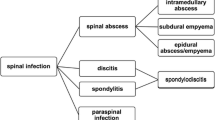Abstract
Infection is a serious complication of surgery to correct scoliosis in patients with cerebral palsy (CP). We obtained multicenter representative figures for deep and superficial infection rates, analyzed risk factors and treatment outcomes, and compared deformity correction relative to infection. We retrospectively reviewed 157 patients who had posterior spinal fusion for CP at one of eight centers. Preoperative and intraoperative variables were subjected to multivariate analysis to determine factors predictive of infection. There were 16 wound infections (10%; nine deep, seven superficial). Only two study factors predicted infection: higher preoperative white blood cell count (8.5 versus 6.4 [in those without infection] × 103) and use of a unit rod (15% versus 5% for bent rods). Fourteen patients underwent irrigation and débridement procedures. Five infections required 2 months or longer to resolve. Two had implant removal. Final curve correction was lower for those with deep infections than those without (67% versus 53%, respectively). We noted a trend toward greater percentages of pain at last followup in those with deep infection than in those without infection (50% versus 18%, respectively) but the study was not adequately powered to confirm this point. Our infection rate in scoliosis surgery for CP was higher than that for most elective spinal deformity surgery.
Level of Evidence: Level III, retrospective case-control study. See Guidelines for Authors for a complete description of levels of evidence.
Similar content being viewed by others
References
Benli IT, Ates B, Akalin S, Citak M, Kaya A, Alanay A. Minimum 10 years follow-up surgical results of adolescent idiopathic scoliosis patients treated with TSRH instrumentation. Eur Spine J. 2007;16:381–391.
Cassidy C, Craig CL, Perry A, Karlin LI, Goldberg MJ. A reassessment of spinal stabilization in severe cerebral palsy. J Pediatr Orthop. 1994;14:731–739.
Jevsevar DS, Karlin LI. The relationship between preoperative nutritional status and complications after an operation for scoliosis in patients who have cerebral palsy. J Bone Joint Surg Am. 1993;75:880–884.
Richards BS, Hasley BP, Casey VF. Repeat surgical interventions following “definitive” instrumentation and fusion for idiopathic scoliosis. Spine. 2006;31:3018–3026.
Sponseller PD, LaPorte DM, Hungerford MW, Eck K, Bridwell KH, Lenke LG. Deep wound infections after neuromuscular scoliosis surgery. Spine. 2000;25:2461–2466.
Szoke G, Lipton G, Miller F, Dabney K. Wound infection after spinal fusion in children with cerebral palsy. J Pediatr Orthop. 1998;18:727–733.
Teli MGA, Cinnella P, Vincitorio F, Lovi A, Grava G, Brayda-Bruno M. Spinal fusion with Cotrel-Dubousset instrumentation for neuropathic scoliosis in patients with cerebral palsy. Spine. 2006;31:E441–E447.
Tsirikos AI, Chang WN, Dabney KW, Miller F. Comparison of one-stage versus two-stage anteroposterior spinal fusion in pediatric patients with cerebral palsy and neuromuscular scoliosis. Spine. 2003;28:1300–1305.
Tsirikos AI, Lipton G, Chang WN, Dabney KW, Miller F. Surgical correction of scoliosis in pediatric patients with cerebral palsy using the unit rod instrumentation. Spine. 2008;33:1133–1140.
Wimmer C, Gluch H. Aseptic loosening after CD instrumentation in the treatment of scoliosis: a report about eight cases. J Spinal Disord. 1998;11:440–443.
Wimmer C, Nogler M, Frischhut B. Influence of antibiotics on infection in spinal surgery: a prospective study of 110 patients. J Spinal Disord. 1998;11:498–500.
Acknowledgments
We thank the following additional surgeons for contributing patients to the study: Daniel Sucato, MD, James Guille, MD, Harry Shufflebarger, MD, Lawrence Lenke, MD, Jurgen Harms, MD, Keith Bridwell, MD, Freeman Miller, MD, Kirk W. Dabney, MD, and Randal R. Betz, MD.
Author information
Authors and Affiliations
Corresponding author
Additional information
One or more authors (PDS, SAS, MFA, PON, LL, MM) received funding from DePuy Spine, Inc through unrestricted support of the Harms Study Group.
Each author certifies that his or her institution has approved or waived approval for the human protocol for this investigation and that all investigations were conducted in conformity with ethical principles of research.
This work was performed at the Johns Hopkins Medical Institutions, Baltimore, MD, the Alfred I duPont Institute, Wilmington, DE, the University of Virginia, Charlottesville, VA, the Rady Children’s Hospital, San Diego, CA, and the Klinikum Karlsbad, Langensteinbach, Germany.
About this article
Cite this article
Sponseller, P.D., Shah, S.A., Abel, M.F. et al. Infection Rate after Spine Surgery in Cerebral Palsy is High and Impairs Results: Multicenter Analysis of Risk Factors and Treatment. Clin Orthop Relat Res 468, 711–716 (2010). https://doi.org/10.1007/s11999-009-0933-4
Received:
Accepted:
Published:
Issue Date:
DOI: https://doi.org/10.1007/s11999-009-0933-4




